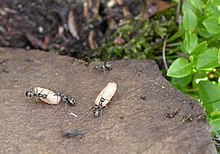
Formica rufibarbis is a European formicine ant of the Formica fusca group. In the classification by Auguste Forel, it is treated in the subgenus Serviformica. F. rufibarbis is subject to a Species Action Plan (SAP) in England, where it is known from only two locations, although it is not considered to be at risk on continental Europe.

Formica is a genus of ants of the family Formicidae, including species commonly known as wood ants, mound ants, thatching ants, and field ants. Formica is the type genus of the Formicidae, and of the subfamily Formicinae. The type species of genus Formica is the European red wood ant Formica rufa. Ants of this genus tend to be between 4 and 8 mm long. Ants belonging to the Formica genus possess a single knob or bump located between their thorax and abdomen. These ants primarily feed on honeydew, a sugary liquid produced by aphids. Formica ants appear to take on a shepherding role with smaller aphids, relocating them to different parts of plants to ensure a continuous food source for the aphids. By doing so, the ants can establish a relatively sustainable honeydew supply for both themselves and their colony.

The Formica rufa group is a subgeneric group within the genus Formica, first proposed by William Morton Wheeler. This group contains the mound-building species of Formica commonly termed "wood ants" or "thatch-mound ants", which build prominent nests consisting of a mound of grass, litter, or conifer needles. The species Formica rufa or the red wood ant is the type species of this subgroup.

Formica rufa, also known as the red wood ant, southern wood ant, or horse ant, is a boreal member of the Formica rufa group of ants, and is the type species for that group, being described already by Linnaeus. It is native to Eurasia, with a recorded distribution stretching from the middle of Scandinavia to the northern Iberia and Anatolia, and from Great Britain to Lake Baikal, with unconfirmed reportings of it also to the Russian Far East. There are claims that it can be found in North America, but this is not confirmed in specialised literature, and no recent publication where North American wood ants are listed mentions it as present, while records from North America are all listed as dubious or unconfirmed in a record compilation. Workers head and thorax are colored red and the abdomen brownish-black, usually with a dorsal dark patches on the head and promensonotum, although some individuals may be more uniform reddish and even have some red on the part of the gastern facing the body. In order to separate them from closely related species, specimens needs to be inspected under magnification, where difference in hairyness are among the telling characteristics, with Formica rufa being more hairy than per example Formica polyctena but less hairy than Formica lugubris. Workers are polymorphic, measuring 4.5–9 mm in length. They have large mandibles, and like many other ant species, they are able to spray formic acid from their abdomens as a defence. Formic acid was first extracted in 1671 by the English naturalist John Ray by distilling a large number of crushed ants of this species. These ants primarily eat honeydew from aphids. Some groups form large networks of connected nests with multiple queen colonies, while others have single-queen colonies.

Formica cunicularia is a species of ant found all over Europe. They are especially common in western Europe and southern England, but they can be found from southern Scandinavia to northern Africa and from Portugal to the Urals. In England, Donisthorpe records the species as having occurred as far north as Bewdley in Worcestershire. In Formica cunicularia, the worker is an ashy grey black color and is usually 4.0–6.5 mm long. The males are found to have a uniformly dark body and are 8.0–9.0 mm long. The queen is yellowish red to dark black and is 7.5–9.0 mm.

An ant colony is a population of a single ant species able to maintain its complete lifecycle. Ant colonies are eusocial, communal, and efficiently organized and are very much like those found in other social Hymenoptera, though the various groups of these developed sociality independently through convergent evolution. The typical colony consists of one or more egg-laying queens, numerous sterile females and, seasonally, many winged sexual males and females. In order to establish new colonies, ants undertake flights that occur at species-characteristic times of the day. Swarms of the winged sexuals depart the nest in search of other nests. The males die shortly thereafter, along with most of the females. A small percentage of the females survive to initiate new nests.
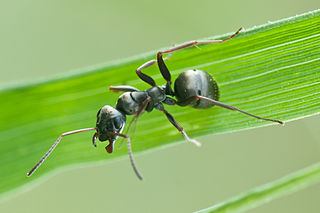
Formica fusca is a black-colored ant commonly found throughout Europe as well as parts of southern Asia and Africa. It has the common names silky ant or dusky ant. The range within the palaearctic region extends from Portugal in the west to Japan in the east and from Italy in the south to Fennoscandia in the north. Populations from North America have been split off as a separate species, Formica subaenescens. F. fusca nests are usually found in rotten tree stumps or under stones in clearcut areas and along woodland borders and hedgerows.

Formica sanguinea, or blood-red ant, is a species of facultative slave-maker ant in the genus Formica characterized by the ability to secrete formic acid. It ranges from Central and Northern Europe through Russia to Japan, China, the Korean Peninsula, Africa and also the United States. This species is coloured red and black with workers up to 7 mm long.
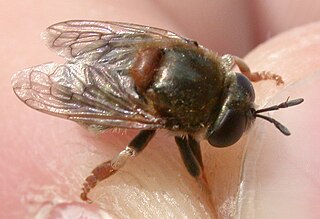
Microdon mutabilis, is a species of hoverfly. It is found in many parts of Britain and Europe. The distinctive almost slug-like larvae live in ants' nests. They are hemispherical in shape, heavily armoured and believed to prey on the eggs and larvae of a number of ant species, including Formica lemani, Formica fusca, Lasius niger and Myrmica ruginodis. It was described by Carl Linnaeus in his landmark 1758 10th edition of Systema Naturae.
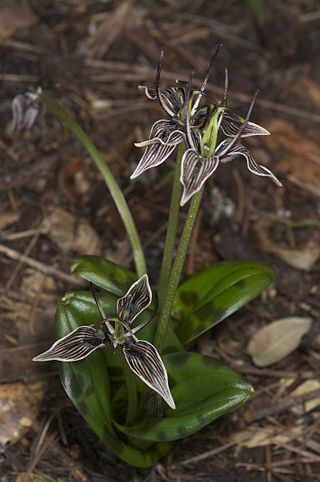
Scoliopus bigelovii is a species of flowering plant in the lily family known by several common names, including California fetid adderstongue, Bigelow's adderstongue, slinkpod, and brownies. It is native to California, where it is known from the Santa Cruz Mountains, parts of the San Francisco Bay Area and North Coast Ranges. It has also been collected just over the border in Oregon. It occurs in old-growth forest in the understory of redwoods. It grows in mossy, moist places, often in shade.
In the 10th edition of Systema Naturae, Carl Linnaeus classified the arthropods, including insects, arachnids and crustaceans, among his class "Insecta". Insects with membranous wings, including bees, wasps and ants were brought together under the name Hymenoptera.

Formica cinerea is a species of ant in the family Formicidae.

Formica pacifica is an ant species occupying the Pacific Coast of the United States and British Columbia, Canada. This species is a member of the Formica fusca species group. Workers are quite fast and aggressive. This species engages in wars with neighboring colonies. F. pacifica is present in both forests and human settlements. Colonies of this species can grow up to a few thousand workers.
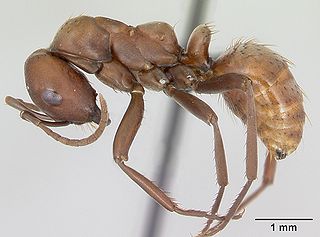
Polyergus rufescens is a species of slave-making ant native to southern Europe and parts of Asia, commonly referred to as the European Amazon ant or as the slave-making ant. It is an obligatory social parasite, unable to feed itself or look after the colony and reliant on ants of another species to undertake these tasks. To replenish these servant ants, it raids nearby ant colonies and carries home pupae and larvae, and these are reared to provide future workers for the colony. A newly mated female P. rufescens needs to make its way into one of these "host" nests, kill the host queen, and be accepted by the host workers in her place.

Polyergus mexicanus is a species of slave-making ant in the subfamily Formicinae. It is the most widely distributed species of Polyergus in North America. It is an obligatory social parasite, unable to feed itself or look after the colony and reliant on ants of another species, Formica, to undertake these tasks. The parasitic ants are known as "dulotics" and the ants they parasitise are known as "hosts".
Formica geradi is a species of ant that is one of two species of the subgenus Formica (Serviformica). The species is mainly distributed to mainland Europe. First described as Iberoformica gerardi in 1917 by Bondroit, it is now considered to be within Formica.
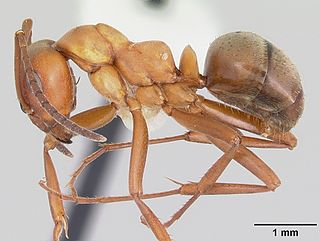
Formica subintegra is a species of slave-making ant in the genus Formica. Formica subintegra seems to be obligate parasites, enslaving ants of the fusca group of Formica. The ants are not active outside the nest except during slave-raids; foraging is conducted entirely by their slaves, which make up 70-90% of the colony.

Formica subsericea, colloquially known as the black field ant, is a species of ant in the genus Formica. It is found in the eastern United States and Canada. Workers of this species are incredibly fast and quite timid. Workers of this species are commonly found working as slaves in Polyergus colonies. Nuptial flights typically occur in July or August. It is often confused with another Formica species, Formica fusca. The larvae of Microdon megalogaster, a member of the ant fly genus, have been observed in the nests of these ants. The inquiline relationship of these fly larvae is not well understood.
Rescue behaviour is a form of altruistic behaviour shown by animals where an individual in distress is aided appropriately by another individual which puts itself at risk in the process. The term "rescue behaviour" was first introduced in the title and in the text of a paper by Wojciech Czechowski, Ewa Joanna Godzińska and Marek Kozłowski (2002) that reported the results of field observations and experiments documenting this behaviour in workers of three ant species, Formica sanguinea, Formica fusca and Formica cinerea that were observed to try to rescue individuals captured by antlion larvae. Criteria allowing to tell apart rescue behaviour from other forms of cooperation and altruism were subsequently provided by Elise Nowbahari and Karen L. Hollis.
